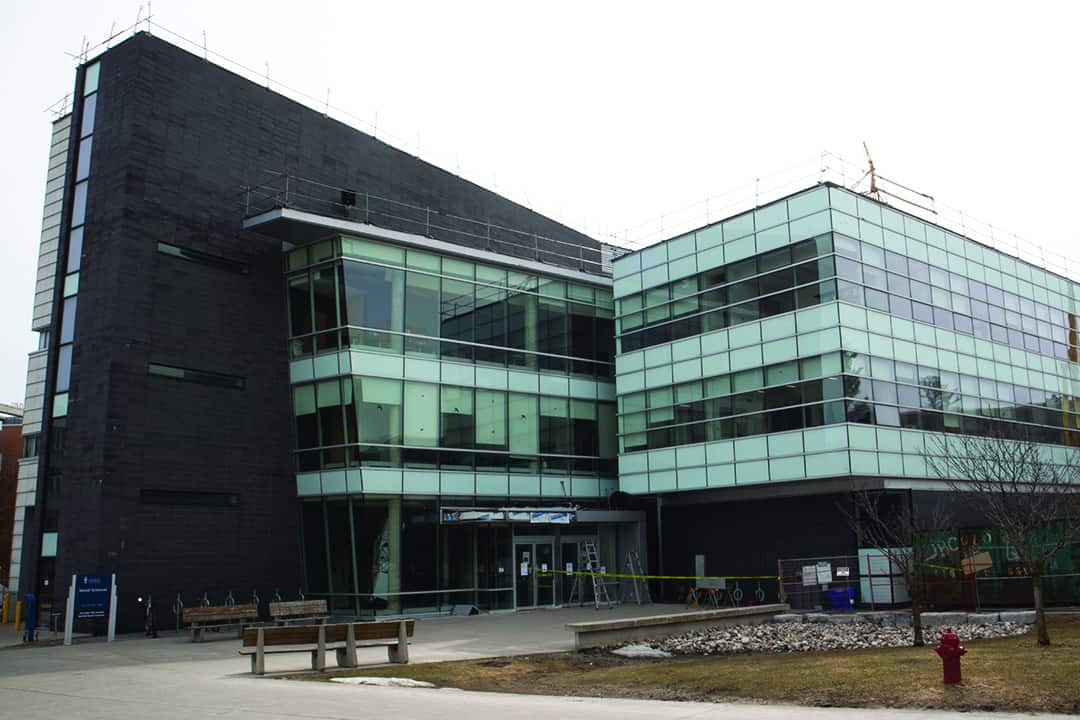In November 2021, Assistant Director of Indigenous Initiatives Kelly Crawford and Assistant Director of the Department of Health and Society Nicholas Spence hosted a virtual discussion forum about the importance of place from an Indigenous perspective. During the session — which all U of T staff, students and faculty were able to attend — participants were asked to contribute to the process of renaming UTSC’s Social Science Building (MW).
At the session, participants suggested themes for a name related to synergies between the building and meaningful spaces, flora and fauna, relational accountability, community and pride in place, and Mother Earth. They also suggested that MW’s new name could represent it as a teaching place, or that its name could honour the original inhabitants of the land that it was built upon.
In a statement to The Varsity, Jennifer Adams Peffer, campus architect and director of architecture, planning and project development at UTSC, described that, because MW’s actual usage no longer fits its name, “[U of T] saw this as an opportunity to engage the community in coming up with a new name that reflects its location, as opposed to its occupants.” Similarly, the Microsoft form that U of T used to collect community members’ input outlined that any suggestions must be based on a descriptor or place, not a person’s name.
Following the form’s March 25 deadline, the UTSC Sub-Committee for Indigenous Place Making will bring those suggestions to U of T’s Truth, Reconciliation and Indigenous Initiatives Advisory Committee for consideration. Peffer explained that the sub-committee is responsible for generating ideas, making recommendations, and offering feedback on initiatives “to support creation of welcoming spaces for Indigenous staff, faculty, students, and community members through visible representations of Indigenous language, knowledge, history, cultures, and art on campus.”
“These visible markers of our commitment to Indigeneity at UTSC include new campus wayfinding, revision of existing wayfinding, naming/renaming buildings, interior, and exterior spaces, and establishing prominent displays of Indigenous art,” Peffer wrote.
U of T reconciliation report
MW was previously referred to as UTSC’s ‘Management Wing’ because it housed the campus’ department of management. However, when the campus’ Instructional Centre opened in 2011, the department of management moved to UTSC’s north campus, and MW instead became known as the Social Sciences Building.
Peffer explained that, last year, UTSC’s Truth, Reconciliation, and Indigenous Initiatives Committee (TRIIAC) deemed “Indigenizing the campus a priority for 2021/2022.” Peffer also wrote that the committee “supported the idea of the MW renaming as part of this endeavour.”
MW’s renaming process also reflects U of T’s Reconciliation Response Report, Answering the Call: Wecheehetowin. The report was written by U of T’s Steering Committee in 2016 as a response to the challenges outlined by Canada’s 2015 Truth and Reconciliation final report. The Truth and Reconciliation final report was created to help address the legacy of residential schools in Canada and “advance the process of reconciliation.” It included 94 Calls to Action which were developed after six years of research and consideration by the Truth and Reconciliation Commission of Canada (TRC).
Answering the Call: Wecheehetowin, whose title was meant to reflect the TRC Calls to Action and the necessity of U of T “building a new relationship with Indigenous communities,” outlined in its preface that the university “must face [the fact that] settler community relations with Indigenous peoples in [Canada] have never been anything other than exploitative and oppressive.” The preface also mentioned that, “for the first time in history,” U of T is taking the recommendations from the TRC and is “[finding] opportunities for building a genuinely new relationship between Indigenous peoples and other peoples” who share Canada.
Each of the working groups consulted in Answering the Call: Wecheehetowin, emphasized that on-campus spaces are crucial to the Indigenous experience at U of T, and that current spaces dedicated to Indigenous communities “were lacking in both number and features.” One group also emphasized the importance of physical space for Indigenous members of U of T’s community, and pointed out that creating “the right environment” for such members is vital “if the University truly wishes to ensure the recruitment, retention, and flourishing of Indigenous people.”
The report also expressed a desire for “more meaningful dedicated Indigenous spaces on all three campuses.” Working groups added that adding to existing spaces on campus was an important way “to render University space more accessible and meaningful to our Indigenous community members.” It noted that the effort to incorporate Indigenous cultures into existing spaces would “aid in the education of the U of T community as a whole about Indigenous people.”
Impact and next steps
In an email to The Varsity, Dr. Angela Mashford-Pringle, a Timiskaming First Nation and assistant professor and associate director at U of T’s Waakebiness-Bryce Institute for Indigenous Health, wrote, “[Changing names] in western settings like UTSC can help start conversations about the history and contemporary uses of the land.”
“By changing the name of a building at UTSC, students may be drawn to understanding why there is a new name and how it came about,” Mashford-Pringle wrote. “It [is] also extremely important to Indigenous students to see that they are welcome in the space.”
Though changing the names of existing spaces to reflect Indigenous cultures is extremely important, Answering the Call: Wecheehetowin proved that U of T still has many steps to take to make the campus a more inclusive setting. Aside from its call to action involving Indigenous spaces, the report also highlighted the need for additional action regarding Indigenous faculty and staff, U of T’s Indigenous curriculum, Indigenous research ethics and community relationships, Indigenous students and co-curricular education, and institutional leadership and implementation.
Such calls to action ultimately echo a message that Mashford-Pringle emphasized in her email to The Varsity: “Name changes should just be the beginning of the process of truth leading to reconciliation.”


